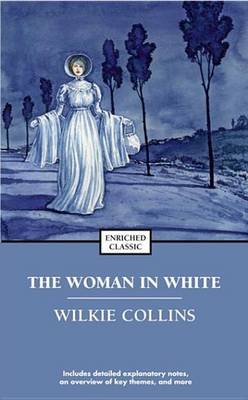Reviewed by brokentune on
So finally, finally I got around to reading the classic that is The Woman in White.
About the book, I am so glad I read it. I didn't love it, but I fully acknowledge that it is a remarkable book and, its time, must have caused quite a stir.
I loved the narration from several points of view - basically, every character got their say at one point. Even a grave stone got a paragraph to tell part of the story!
I loved the plot and the twists - but I won't go into them because, erm, spoilers and such - even tho I already had a good idea of where the plot was going to go.
I loved that there was such a mix of characters. From the courageous, to the devious, to the whiny, to the downright pathetic. And no, the "hero" of the piece was not necessarily the best character.
In fact, Walter Hartwright was such an annoying, whiny, lovesick puppy for the first part of the book that I felt some great relief when another character took over the narration.
Luckily, Walter improved later in the book. (Although, he remained a condescending git.)
The second main character, Laura, was no better. If there was a quote to describe her, this would be my pick:
"I am so useless— I am such a burden on both of you," she answered, with a weary, hopeless sigh. "You work and get money, Walter, and Marian helps you. Why is there nothing I can do? You will end in liking Marian better than you like me— you will, because I am so helpless! Oh, don't, don't, don't treat me like a child!"
Luckily, Laura is absent for much of the book because.....ahaha....it's a mystery.
No, my favourite character of this book was Marian Halcombe, whom Walter (the main character) describes as follows on their first encounter:
The easy elegance of every movement of her limbs and body as soon as she began to advance from the far end of the room, set me in a flutter of expectation to see her face clearly. She left the window— and I said to myself, The lady is dark. She moved forward a few steps— and I said to myself, The lady is young.
She approached nearer— and I said to myself (with a sense of surprise which words fail me to express), The lady is ugly!
Never was the old conventional maxim, that Nature cannot err, more flatly contradicted— never was the fair promise of a lovely figure more strangely and startlingly belied by the face and head that crowned it. The lady's complexion was almost swarthy, and the dark down on her upper lip was almost a moustache.
She had a large, firm, masculine mouth and jaw; prominent, piercing, resolute brown eyes; and thick, coal-black hair, growing unusually low down on her forehead. Her expression— bright, frank, and intelligent— appeared, while she was silent, to be altogether wanting in those feminine attractions of gentleness and pliability, without which the beauty of the handsomest woman alive is beauty incomplete.
Well, as I said, Walter was a bit of a git. However, this is one of the examples in the book that shows how Collins set out his narratives and that he did to include humor, even if it was kinda shallow.
Some of us rush through life, and some of us saunter through life. Mrs. Vesey SAT through life.
All of this was very well. Good writing, a well laid out plot, a romantic element, experimental writing (for its time), fascinating characters, ...
So, why did The Woman in White not sweep me off my feet?
I guess the simple answer to this is that the story dragged. A LOT. I'm at a loss to see why we needed to read the Third Epoch, other than this having being printed as a serial originally and Collins obviously kept the story going for a paycheck.
Had he cut some of the overly detailed explanations at the end I would have enjoyed this much, much more. Alas, he didn't. Just could not come to the point, which reminded me of all the things that were so annoying about Walter in the beginning of the book - it took him ages to come to a conclusion about his feelings that were just so obvious:
I loved her. Ah! how well I know all the sadness and all the mockery that is contained in those three words. I can sigh over my mournful confession with the tenderest woman who reads it and pities me. I can laugh at it as bitterly as the hardest man who tosses it from him in contempt. I loved her! Feel for me, or despise me, I confess it with the same immovable resolution to own the truth.
No shit, Sherlock.
Reading updates
- Started reading
- 17 January, 2017: Finished reading
- 17 January, 2017: Reviewed
